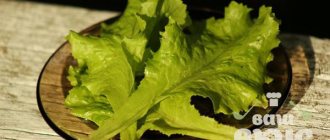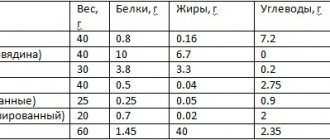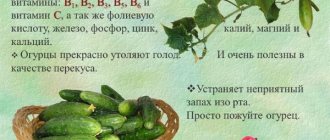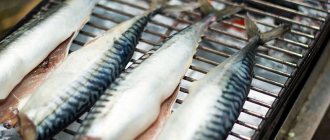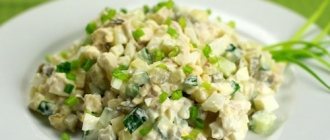Lettuce, also known as green or leaf lettuce (Lactuca sativa L.) is a herbaceous plant of the Asteraceae family, a valuable vegetable crop. The nutritional and beneficial properties of lettuce were known back in ancient Rome. Salad was one of the most popular foods in southern Europe - it was eaten with olive oil and salt, often as a side dish for meat and fish.
Nowadays it is cultivated as a vegetable plant all over the world. There are more than a hundred different species - they differ in the shape and color of the leaves, taste, and growing conditions. They are mainly divided into head and leaf varieties of lettuce. And almost all varieties of green salad are a healthy and tasty food product.
Chemical composition
The enormous benefits of lettuce as a vegetable crop are explained by its rich chemical composition. The leaves of the plant consist of water, fiber, carbohydrates, a small amount of protein and fat.
The composition of green salad contains a lot of useful elements: iron, phosphorus, iodine, cobalt, zinc, sodium, potassium, copper. The leaves contain a lot of vitamin K, which regulates such an important indicator as blood clotting. In terms of vitamin C content, almost all types of leaf lettuce are superior to citrus fruits - lemons and oranges.
Also, lettuce, which contains a lot of carotene and carotenoids, has a beneficial effect on vision. The beneficial properties of green salad are also that due to the high content of folic acid, it is absolutely necessary for pregnant and lactating women, as well as children for normal skeletal formation and bone development.
Calorie content of salad and weight loss
The salad seems to have been created specifically to be added to the diet during various diets. The high content of vitamins and microelements plays an extremely important role in conditions of a limited diet, and the low calorie content allows you not to overeat and comply with daily calorie restrictions.
Salad in diets should be combined with carbohydrates and proteins - meat, poultry, fish, vegetables, nuts, cheeses. You can use it as the basis of vegetable salads, combining it with tomatoes, cucumbers, bell peppers, and olives. Such dishes are best seasoned with olive oil and lemon juice, and to enhance the fat-burning effect, you can add garlic, ginger or cinnamon.
You can also arrange fasting days on salad - the low calorie content will allow you to keep your daily calorie intake within 1000 kcal, without suffering from hunger. When fasting on salad, you need to eat at least 500-700 grams of this salad and 1 kg of any other green vegetables or tomatoes. Vegetable salads can be seasoned with a spoon of olive oil and lemon juice.
During the day you need to drink enough water or green tea - at least 1.5 liters. In one such fasting day, you can cleanse the intestines, remove excess fluid from the body, rid your body of toxins, and repeating such fasting days once a month will allow you to lose weight smoothly and steadily.
Lettuce is a one- or two-year-old garden crop of the Asteraceae
. Information that lettuce was eaten is found in documents describing the existence of the ancient Roman Empire; before that time, lettuce was grown for its seeds, from which oil was squeezed out. The exact geographical place of origin of the first types of lettuce has not been historically established.
Lettuce has many varieties, the most common, leaf lettuce, has long, tender shoots in the shape of oak leaves, light green (light green) color. Lettuce leaves are juicy, crunchy, with a fresh smell, and can vary in shape and quantity located on one root or head.
[custom_ads_shortcode3]
Benefit
Experts believe that regular consumption of lettuce, due to its beneficial properties, can prevent the development of Alzheimer’s disease, strengthen the skeleton and bone tissue, improve the digestive process due to its high fiber content, improve the condition of teeth, skin, mucous membranes of the body, and compensate for the deficiency of vitamins and minerals. .
Useful properties of Iceberg lettuce, caloric content of the product and energy value
Iceberg lettuce
– an excellent option for those who adhere to the rules of proper nutrition.
The benefits of fresh greens in the human diet have been repeatedly confirmed by many nutritionists. The rich vitamin composition of the product and the low calorie content of Iceberg lettuce
provide the human body with valuable elements, and this in no way affects the figure.
In appearance, the salad resembles ordinary cabbage. It belongs to the head lettuce category. In addition to the juicy leaves enriched with vitamins, you can also eat the head of cabbage.
Calorie content
Leaf lettuce, which has very low calorie content - only 15 calories per 100 grams of green leaves - is an ideal dietary product. It is credited with its ability to lower blood sugar and counteract obesity. Due to the high content of ascorbic acid, green leaf lettuce is an excellent antioxidant and resists cell aging.
It is usually eaten fresh - mainly as part of vitamin salads, fresh snacks, and side dishes for various dishes.
Calorie content of lettuce. Chemical composition and nutritional value.
Nutritional value and chemical composition of “Leaf lettuce”.
The table shows the nutritional content (calories, proteins, fats, carbohydrates, vitamins and minerals) per 100 grams of edible portion.
| Nutrient | Quantity | Norm** | % of the norm in 100 g | % of the norm in 100 kcal | 100% normal |
| Calorie content | 14 kcal | 1684 kcal | 0.8% | 5.7% | 12029 g |
| Squirrels | 1.2 g | 76 g | 1.6% | 11.4% | 6333 g |
| Carbohydrates | 1.8 g | 219 g | 0.8% | 5.7% | 12167 g |
| Organic acids | 0.1 g | ~ | |||
| Alimentary fiber | 1.2 g | 20 g | 6% | 42.9% | 1667 g |
| Water | 95 g | 2273 g | 4.2% | 30% | 2393 g |
| Ash | 1 g | ~ | |||
| Vitamins | |||||
| Vitamin A, RE | 292 mcg | 900 mcg | 32.4% | 231.4% | 308 g |
| beta carotene | 1.75 mg | 5 mg | 35% | 250% | 286 g |
| Vitamin B1, thiamine | 0.03 mg | 1.5 mg | 2% | 14.3% | 5000 g |
| Vitamin B2, riboflavin | 0.08 mg | 1.8 mg | 4.4% | 31.4% | 2250 g |
| Vitamin B4, choline | 13.6 mg | 500 mg | 2.7% | 19.3% | 3676 g |
| Vitamin B5, pantothenic | 0.1 mg | 5 mg | 2% | 14.3% | 5000 g |
| Vitamin B6, pyridoxine | 0.18 mg | 2 mg | 9% | 64.3% | 1111 g |
| Vitamin B9, folates | 48 mcg | 400 mcg | 12% | 85.7% | 833 g |
| Vitamin C, ascorbic acid | 15 mg | 90 mg | 16.7% | 119.3% | 600 g |
| Vitamin E, alpha tocopherol, TE | 0.7 mg | 15 mg | 4.7% | 33.6% | 2143 g |
| Vitamin H, biotin | 0.7 mcg | 50 mcg | 1.4% | 10% | 7143 g |
| Vitamin K, phylloquinone | 126.3 mcg | 120 mcg | 105.3% | 752.1% | 95 g |
| Vitamin RR, NE | 0.9 mg | 20 mg | 4.5% | 32.1% | 2222 g |
| Niacin | 0.7 mg | ~ | |||
| Macronutrients | |||||
| Potassium, K | 220 mg | 2500 mg | 8.8% | 62.9% | 1136 g |
| Calcium, Ca | 77 mg | 1000 mg | 7.7% | 55% | 1299 g |
| Silicon, Si | 8.2 mg | 30 mg | 27.3% | 195% | 366 g |
| Magnesium, Mg | 40 mg | 400 mg | 10% | 71.4% | 1000 g |
| Sodium, Na | 8 mg | 1300 mg | 0.6% | 4.3% | 16250 g |
| Sera, S | 16 mg | 1000 mg | 1.6% | 11.4% | 6250 g |
| Phosphorus, P | 34 mg | 800 mg | 4.3% | 30.7% | 2353 g |
| Chlorine, Cl | 50 mg | 2300 mg | 2.2% | 15.7% | 4600 g |
| Microelements | |||||
| Aluminium, Al | 570 mcg | ~ | |||
| Bor, B | 85 mcg | ~ | |||
| Vanadium, V | 170 mcg | ~ | |||
| Iron, Fe | 0.6 mg | 18 mg | 3.3% | 23.6% | 3000 g |
| Yod, I | 8 mcg | 150 mcg | 5.3% | 37.9% | 1875 |
| Cobalt, Co | 4 mcg | 10 mcg | 40% | 285.7% | 250 g |
| Lithium, Li | 40 mcg | ~ | |||
| Manganese, Mn | 0.3 mg | 2 mg | 15% | 107.1% | 667 g |
| Copper, Cu | 120 mcg | 1000 mcg | 12% | 85.7% | 833 g |
| Molybdenum, Mo | 9 mcg | 70 mcg | 12.9% | 92.1% | 778 g |
| Nickel, Ni | 5 mcg | ~ | |||
| Rubidium, Rb | 153 mcg | ~ | |||
| Selenium, Se | 0.6 mcg | 55 mcg | 1.1% | 7.9% | 9167 g |
| Strontium, Sr | 7.9 mcg | ~ | |||
| Fluorine, F | 28 mcg | 4000 mcg | 0.7% | 5% | 14286 g |
| Chromium, Cr | 3 mcg | 50 mcg | 6% | 42.9% | 1667 g |
| Zinc, Zn | 0.27 mg | 12 mg | 2.3% | 16.4% | 4444 g |
| Digestible carbohydrates | |||||
| Starch and dextrins | 0.4 g | ~ | |||
| Mono- and disaccharides (sugars) | 1.6 g | max 100 g | |||
| Essential amino acids | 0.485 g | ~ | |||
| Valin | 0.075 g | ~ | |||
| Histidine* | 0.021 g | ~ | |||
| Isoleucine | 0.053 g | ~ | |||
| Leucine | 0.071 g | ~ | |||
| Lysine | 0.1 g | ~ | |||
| Methionine | 0.037 g | ~ | |||
| Methionine + Cysteine | 0.05 g | ~ | |||
| Threonine | 0.07 g | ~ | |||
| Tryptophan | 0.014 g | ~ | |||
| Phenylalanine | 0.065 g | ~ | |||
| Phenylalanine+Tyrosine | 0.1 g | ~ | |||
| Nonessential amino acids | |||||
| Tyrosine | 0.037 g | ~ | |||
| Cysteine | 0.015 g | ~ | |||
| Saturated fatty acids | |||||
| Saturated fatty acids | 0.02 g | max 18.7 g | |||
| Polyunsaturated fatty acids | |||||
| Omega-3 fatty acids | 0.058 g | from 0.9 to 3.7 g | 6.4% | 45.7% | |
| Omega-6 fatty acids | 0.024 g | from 4.7 to 16.8 g | 0.5% | 3.6% |
The energy value of lettuce is 14 kcal.
Primary Source: Created in the application by the user. Read more.
** This table shows the average levels of vitamins and minerals for an adult. If you want to know the norms taking into account your gender, age and other factors, then use the “My Healthy Diet” application.
Application
Fresh lettuce leaves are often used in Mediterranean cuisine. They are added to salads, sandwiches, and decorate dishes. It is recommended to chop the salad by hand, since the substances included in its composition react with the metal of the knife and an oxidation process occurs. Lettuce leaves are used to wrap the filling. Sometimes added to soups at the very end of cooking.
Market Analytics
- Global cosmetics market 2021: an unprecedented test for the global cosmetics industry
- Top 10 Cosmetic Research and Development of 2021
- 2020 in the beauty industry – innovation without borders
Convenient search for beauty salons on our website
Beauty salons in Moscow Beauty salons in St. Petersburg Beauty salons in Ekaterinburg Beauty salons in Novosibirsk
Latest blog posts on our website
- Naturecream / Properties of the “Sunny” oil itself
- Naturecream / “Sugar” wrinkles - or what glycation can do
- Naturecream / Esterified oils
- Naturecream / Arnica - the magical plant of alchemists
- Naturecream / Tremella Extract - Snow Mushroom Detox for Skin
- Prostye-sovety / How to visually enlarge your lips with makeup
- Naturecream / Apricot kernel oil for face
- Naturecream / MATRIXYL3000 - the best skin elasticity stimulator
- Naturecream / SPF in Natural Oils
- Naturecream / Geranium (Pelargonium) oil for skin health and beauty
Latest forum topics on our website
- Natalya / How to properly make a gelatin mask?
- Mrs._Smith / Badly sunburned! What to do?((
- Ice / Is it necessary to combine fitness classes with a diet?
- Antonova / What can be used for hair loss?
- Radio operatorKat / Who was on a protein diet?
Other articles in this section
| Black garlic Black garlic was first produced in South Korea, where it became very popular due to its nutritional properties. Unlike regular garlic, its black cousin contains almost twice as many antioxidants, is rich in natural sugars and amino acids, and does not contain the components that cause the usual pungent garlic smell. Garlic turns black through a special fermentation process, a method invented in the early 2000s. |
| Dried Milk Thistle Milk thistle, also known as milk thistle, has been used for over two thousand years as an herbal remedy for liver, kidney and gallbladder diseases. The herb has a very bitter taste. This annual plant belongs to the Asteraceae family. Milk thistle leaves are edged with thorns, purple flowers are collected in a basket. The most valuable part of the plant is the seeds. Milk thistle is native to the Mediterranean region. |
| Parsley Parsley belongs to the plants of the Umbelliferae family and is a relative of carrots, celery, dill, fennel, parsnips and other vegetable crops. There are two main types of parsley - common leaf (or Italian) and curly. Common parsley has smooth, dark green leaves and is more aromatic. Curly parsley has intricately indented leaf edges. |
| Jerusalem artichoke Jerusalem artichoke is a root crop of the sunflower genus of the Asteraceae family, native to the central regions of North America. It is sometimes called the “Jerusalem artichoke” or “earth apple”. Jerusalem artichoke tubers are round in shape and covered with brown, purple or pink skin. The average weight of a tuber is 100-200 g. The fruit pulp is white and sweetish, contains starch. In many countries of Western Europe and the Mediterranean region, Jerusalem artichoke is used in the same way as potatoes. |
| Grape leaves Grape leaves have been an integral part of Greek, Turkish, Romanian and Vietnamese cooking since ancient times. They are dark green vegetables, which are recommended to be included in the diet at least 100 g per week. |
| Arugula A leafy green vegetable of the cruciferous family, arugula is a close relative of cauliflower. It is an annual herbaceous plant with leaves similar to spinach, but arugula is easily identified by its white flowers. Young arugula leaves have a sweeter taste, while mature arugula leaves have a more spicy and tangy taste and aroma. |
| Romaine lettuce Romaine lettuce, or romaine, has been cultivated since ancient times. Also sometimes called cos salad. Its homeland is in the eastern Mediterranean. From the 5th century n. e. Romaine lettuce began to be grown in China. There it was considered a symbol of good luck. Romano was served on the table on holidays - New Year, birthdays. It differs from lettuce in having larger, dark green leaves with a crunchy texture. |
| Sauerkraut The first mention of sauerkraut dates back to Ancient China. During the Roman Empire, it became known in Europe, primarily in Germany and the countries of Eastern Europe. In an era when keeping food fresh was a rather difficult task, pickled foods were highly valued. Sauerkraut serves as an excellent side dish for a number of dishes, and is also useful for any diet. |
| Salsify Salsify is a vegetable plant of the Asteraceae family, native to Europe. The plant got its name because the flowering head resembles a goat's beard. Salsify roots were a popular food item in the 16th century. In the 20th century it was remembered again thanks to its oyster taste. |
| Red cabbage Among all the cruciferous vegetables, red cabbage is distinguished by its bright color. The color varies from a rich red-burgundy hue to purple, depending on the acidity of the soil in which the cabbage grew. It differs from white cabbage in its long shelf life; it does not need to be salted or pickled for the winter. Red cabbage is grown in Northern Europe, America and some areas of China. |
The most of the most
If we strictly talk about calorie content, then the very, very low-calorie
and an easy-to-make fresh salad is
the lettuce salad
.
Season the chopped lettuce leaves with a sauce made from vegetable oil and vinegar, mixed in equal proportions. Chopped dill will complete the picture. The calorie content per 100 grams of this salad is only 12 kcal!
But in order to eat this salad often, you need to really love greens or have great willpower. Low-calorie salads include all salads made from non-starchy green vegetables - spinach, celery, cucumbers, radishes, cabbage. The more traditional and beloved salad of cucumbers and tomatoes is also low-calorie (if seasoned with vegetable oil, then 100 grams contains 46 kcal
). Read more about cucumber and tomato salad in a separate article.
Vinaigrette, popular in the autumn-winter period, can be called a medium-calorie salad. So, the simplest vinaigrette without beans will amount to 131 kcal per 100 grams
. look in the article about this multi-variant salad.
High-calorie salads include salads with a large number of ingredients, with vegetables containing starch, with meat, seasoned with mayonnaise or even fattier dressings. Interestingly, Caesar salad
, which many consider dietary, thanks to the dressing, it has
500 kcal per 100 grams.
It is also important that the chicken in the salad is not very fatty.
"Olivie"
, which is guilty of being high in calories, will give you only
284 kcal
.
If you replace boiled sausage with chicken breast, then only 234 kcal. Another symbol of the holiday is the salad “Herring under a fur coat” - 193 kcal per 100 grams.
Another thing is that here you need to know when to stop and even on a holiday not to eat these mayonnaise salads in bowls.
Obviously, vegetable salads should be on our menu every day. But with the onset of autumn coolness and winter cold, the body objectively requires something more nutritious. And then we recommend adding meat to salads - primarily chicken. Boiled chicken breast is a great and substantial addition to a green salad base like arugula and celery.
With low-fat yogurt, the calorie content of such a salad will not exceed 83 kcal per 100 grams. If desired, you can replace the chicken with beef. Beef salad with vegetables
It will also be low in calories (
113 kcal per 100 grams
) and very healthy. If your husband said to a vegetable salad - eat it yourself, then the whole family will be happy to eat such a nutritious salad with you for dinner.
All seafood is fantastically low in calories. If you love, know how to choose and cook, feel free to add squid, shrimp, and mussels to vegetable salads. The calorie content of such a dietary dish will not exceed 90-100 kcal per 100 grams. And, of course, from time to time you can pamper yourself and your loved ones with salads with fish - boiled, smoked, salted.
These salads cannot be called low-calorie or dietary, but they are very nutritious and rich in fatty amino acids necessary for the body. For example, red fish salad
– lightly salted salmon – with potatoes and cucumber has
254 kcal per 100 grams
. But we recommend not using chips and croutons in salads at all. These products not only add extra calories to the salad, they are a fly in the ointment that spoils the usefulness of other ingredients.
A little about the salad
Paradoxically, people rarely include lettuce in their diet. Its calorie content is quite low, and therefore you cannot get enough of it. This product often serves as a decoration for holiday dishes, which are generously topped with mayonnaise. If we talk about supporters of diets and proper nutrition, then they know the price of fresh lettuce well.
It is worth noting that at the moment there are more than 1000 varieties of salads in the world. This is an annual (in some cases biennial) plant that belongs to the Asteraceae, or Asteraceae, family. so many that sometimes even experienced gardeners get confused about them.
In ancient times, this crop was grown exclusively for the oil that was extracted from the seeds. Later, tender leaves appeared on the table of the ancient Greeks and Romans. They appreciated not only the taste, but also the healing qualities of this product.
Salad in cosmetology
Lettuce leaves are useful not only for the internal systems of the body. This product helps maintain external beauty and solve a number of cosmetic problems. So, if you have dry skin, then apply a mask of sour cream with crushed green leaves twice a week. If your skin needs intensive nutrition, it is recommended to use a product consisting of lettuce pulp, vegetable oil and lemon juice. This mask will help you cope with freckles and pigmentation. If the epidermis is too dry, you can add egg yolk. During the cold season, the skin is prone to irritation and peeling. To eliminate these unpleasant symptoms, it is enough to wipe your face with a decoction of lettuce leaves several times a day. This remedy is also great for burns and insect bites. In summer, skin needs protection more than ever. If you are afraid that your face or shoulders will burn, it is not at all necessary to apply a special cream. Before going outside, apply a lettuce leaf to your skin for a few minutes, after beating it with a rolling pin or crushing it in your hands.
Iceberg lettuce in cooking
The taste of Iceberg is not much different from a simple leaf lettuce. Perhaps the only difference is that when consumed it makes a peculiar crunch. The product contains only 14 kcal, which is why Iceberg lettuce is
It is considered a very popular product.
Due to their density and stability, lettuce leaves are often used in addition to preparing dishes and also for decorating them. As for the dishes themselves, there are many recipes that use not only lettuce leaves, but also heads of cabbage.
The benefits of salads for weight loss
Any nutritionist will tell you that anyone who wants to reduce their weight noticeably and for a long time needs to start eating healthy. And a healthy diet necessarily includes the oldest dish of world cuisine - salad. Of course, preference should be given to vegetable salads with low calorie content.
When losing weight, a vegetable salad performs several functions at once - it satisfies the feeling of hunger and fills the stomach, nourishes the body with useful microelements and vitamins, and also serves as a kind of “broom” - it cleanses the intestines and improves metabolism. As with everything, you need to approach the preparation of salads wisely and lovingly.
In spring, summer and autumn, it is advisable to choose vegetables for salad at the market, and not in the supermarket. In winter, it is better to “click” on sauerkraut with onions - a rich storehouse. Season with vegetable oil and you can safely eat a fairly large portion. Neither excess weight nor colds will bother you.
